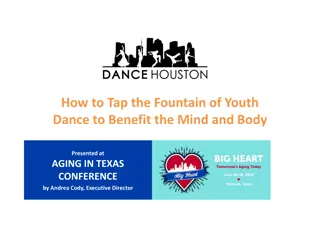Understanding the Trinity: The Dynamic Dance of Divine Love
Christianity uniquely teaches the doctrine of the Trinity, revealing God as a relational being existing eternally in three persons: Father, Son, and Holy Spirit. This concept illustrates a dynamic, self-giving love among the three divine persons, creating a beautiful dance of mutual glorification, adoration, and delight. Rather than being self-centered, the Trinity exemplifies a continual flow of love and joy among the Father, Son, and Spirit, symbolizing a harmonious and eternal relationship of love.
Uploaded on Sep 14, 2024 | 0 Views
Download Presentation

Please find below an Image/Link to download the presentation.
The content on the website is provided AS IS for your information and personal use only. It may not be sold, licensed, or shared on other websites without obtaining consent from the author. Download presentation by click this link. If you encounter any issues during the download, it is possible that the publisher has removed the file from their server.
E N D
Presentation Transcript
Christianity, alone among the world faiths, teaches that God is triune. The doctrine of the Trinity is that God is one being who exists eternally in three persons: Father, Son and Holy Spirit. The Trinity means that God is, in essence, relational. The Gospel writer John describes the Son as living from all eternity in the bosom of the Father (John 1:18), an ancient metaphor for love and intimacy. Later in John s Gospel, Jesus, the Son, describes the Spirit as living to glorify him (John 16:14).
In turn, the Son glorifies the Father (17:4) and the Father, the Son (17:5). This has been going on for all eternity (17:5b). What does the term glorify mean? To glorify something or someone is to praise, enjoy and delight in them. When something is useful you are attracted to it for what it can bring you or do for you. But if it is beautiful, then you enjoy it simply for what it is. Just being in its presence is its own reward. To glorify someone is also to serve or defer to him or her. Instead of sacrificing their interests to make yourself happy, you sacrifice your interests to make them happy. Why? Your ultimate joy is to see them in joy.
What does it mean, then, that the Father, Son and Holy Spirit glorify one another? If we think of it graphically, we could say that self-centeredness is to be stationary, static. In self-centeredness we demand that others orbit around us. We will do things and give affection to others, as long as it helps us meet our personal goals and fulfils us. The inner life of the triune God, however, is utterly different. The life of the Trinity is characterized not by self-centeredness but by mutually self-giving love. When we delight and serve someone else, we enter into a dynamic orbit around him or her, we centre on the interests and desires of the other.
That creates a dance, particularly if there are three persons, each of whom moves around the other two. So it is, the Bible tells us. Each of the divine persons centers upon the others. None demands that the others revolve around him. Each voluntarily circles the other two, pouring love, delight and adoration into them. Each person of the Trinity loves, adores, defers to and rejoices in the others. That creates a dynamic, pulsating dance of joy and love. The early leaders of the Greek church had a word for this perichoresis. Notice the root of our word choreography within it. It means literally to dance or flow around . Timothy Keller: The Reason For God























